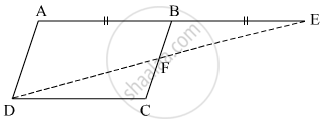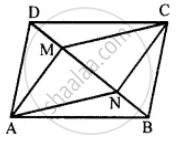Advertisements
Advertisements
प्रश्न
Ratio of consecutive angles of a quadrilateral is 1 : 2 : 3 : 4. Find the measure of its each angle. Write, with reason, what type of a quadrilateral it is.
उत्तर
Suppose PQRS is a quadrilateral.

Let m∠P : m∠Q : m∠R : m∠S = 1 : 2 : 3 : 4
So, m∠P = k, m∠Q = 2k, m∠R = 3k and m∠S = 4k, where k is some constant
Now,
m∠P + m∠Q + m∠R + m∠S = 360°
∴ k + 2k + 3k + 4k = 360°
⇒ 10k = 360°
⇒ k = 36°
∴ m∠P = 36°
m∠Q = 2k = 2 × 36° = 72°
m∠R = 3k = 3 × 36° = 108°
m∠S = 4k = 4 × 36° = 144°
Now, m∠P + m∠S = 36° + 144° = 180°
We know if two lines are intersected by a transversal such that the sum of interior angles on the same transversal is supplementary, then the two lines are parallel.
∴ Side PQ || Side SR
Also, m∠P + m∠Q = 36° + 72° = 108° ≠ 180°
So, side PS is not parallel to side QR.
In quadrilateral PQRS, only one pair of opposite sides is parallel. Therefore, quadrilateral PQRS is a trapezium.
संबंधित प्रश्न
The measures of two adjacent angles of a parallelogram are in the ratio 3 : 2. Find the measure of each of the angles of the parallelogram.
Perimeter of a parallelogram is 150 cm. One of its sides is greater than the other side by 25 cm. Find the lengths of all sides.
In the given figure, `square`PQRS and `square`ABCR are two parallelograms. If ∠P = 110° then find the measures of all angles of `square`ABCR.

In the given figure, `square`ABCD is a parallelogram. Point E is on the ray AB such that BE = AB then prove that line ED bisects seg BC at point F.

In the given figure, if points P, Q, R, S are on the sides of parallelogram such that AP = BQ = CR = DS then prove that `square`PQRS is a parallelogram.

Construct ☐ BARC such that l(BA) = l(BC) = 4.2 cm, l(AC) = 6.0 cm, l(AR) = l(CR) = 5.6 cm
Prove that the diagonals of a parallelogram bisect each other.
The given figure shows parallelogram ABCD. Points M and N lie in diagonal BD such that DM = BN.

Prove that:
(i) ∆DMC = ∆BNA and so CM = AN
(ii) ∆AMD = ∆CNB and so AM CN
(iii) ANCM is a parallelogram.
In parallelogram ABCD, the angle bisector of ∠A bisects BC. Will angle bisector of B also bisect AD? Give reason.
Construct a parallelogram ABCD in which AB = 4 cm, BC = 5 cm and ∠B = 60°.
